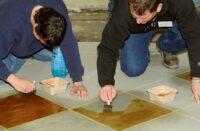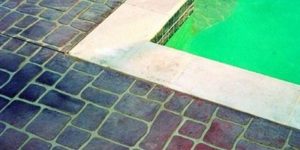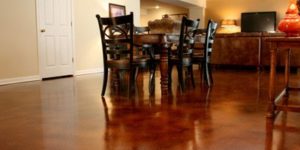
When Shellie Rigsby talks about her artistic philosophy, she starts with her company’s mission statement. Here it is, right from the Web site: “The mission of our company, Acanthus Inc., is to advance and enhance the building industry with comprehensive design, superior products, uncompromising standards, and unsurpassed craftsmanship. Concrete is treated as an expansive canvas, which will ultimately reflect the essence of the owner and theatmosphere specific to the project.”
Rigsby wrote that in late 1998, during her first month of business as a decorative concrete artisan, and she stands by it today. “The mission statement really means something,” she says. “Everything we do and everydecision we makefits our mission statement.”
When it comes to decorative concrete, Shellie Rigsby does a lot. She’s known particularly for her work with concrete stains. Her first book, “The Complete Guide to Stained Concrete,” is published by Thomson Custom Solutions, a unit of Thomson Learning, and will debut at the 2007 World of Concrete exposition.
She makes how-to videos and does training sessions, including an American Institute of Architects (AIA) continuing education program for architects and interior designers she is launching in early 2007. She has appeared on a number of television shows, often at the request ofcompanies that manufacture decorative concrete products.
She was one of several artists featured at the Artistry in Concrete demos at World of Concrete 2005. She developed and executed a working project for the Partnership for Advancing Technology in Housing. She even serves as an expert witness for law firms.
Rigsby, 39, started working with decorative finishes on cars, not floors, when she was a young girl in her father’s auto body shop. “I spent many hours masking, compounding, sanding and pinstriping,” she says, “and doing all the things little fingers could do.”
 Many of the skills she learned on cars at her father’s side translated naturally to what she does with floors on her own. Fiberglass molds are similar to stamps, she says. There’s not much difference between pinstriping and laying down tape.
Many of the skills she learned on cars at her father’s side translated naturally to what she does with floors on her own. Fiberglass molds are similar to stamps, she says. There’s not much difference between pinstriping and laying down tape.
Rigsby has explored Venetian plastering and faux finishes. But for the past decade, since shortly before the youngest of her three children entered school, she has focused on decorative concrete. When she started, she spent two years researching concrete stains, and like many budding concrete artists in the mid-to-late 1990s, was often frustrated by the scarcity of products and information. Concrete stains were just beginning to be seen here and there, she says, and most stores did not carry reactive stains. “I didn’t know where to find the product. All I would find were paints.”
Her first stain job was a room in her own home, but demand quickly snowballed. “By the time I was finished, I had more work than I knew what to do with,” she says.
Rigsby began devouring classes on floating, troweling, and other skills related to concrete floors. “I knew there was so much I could do. I could see it but I didn’t know how.”
 All those bits and pieces of knowledge expanded her reach beyond simple staining. “The skillsets became like tools in my toolbox. You don’t need a drill on every job, but you need a drill in your toolbox. You must possess the knowledge within the box before you can think outside the box.”
All those bits and pieces of knowledge expanded her reach beyond simple staining. “The skillsets became like tools in my toolbox. You don’t need a drill on every job, but you need a drill in your toolbox. You must possess the knowledge within the box before you can think outside the box.”
Frankly, she’s outgrown her old specialty. “At first I wanted that natural organic polished stone look, and the best for that is reactive acid stain,” she says. “Now I understand the opportunities are so much greater than just polished stone. I can go beyond polished stone. I cancreate works of art.”
Rigsby’s artistic credo is to start with a fleshed-out conception of what the final floor should look like, then work backward and figure out how to achieve that effect. The floor she designed for the Seabreeze Church youth center in Huntington Beach, Calif., came together exactly that way. Her concept involved compiling and blending full-color designs submitted by area youth. Once she had the designs, she figured out how to besttransfer the images onto the floor without losing detail.

Not every decorative project she does is an attempt at a showpiece. “I make a great effort not to overdesign a floor,” she says. “Sometimes simplicity is the answer.”
Sometimes simplicity is more important than even attractiveness. At the Holocaust Museum in Dallas, she created thefloor for an exhibit that features a railcar used to transport prisoners to concentration camps. “A beautiful, glossy, ornate floor would have been all wrong. The design was to look like a ghetto street.”
The project was challenging technically as well as aesthetically. The slab Rigsby was commissioned to stain was gypcrete, a lightweight, powdery porous floor system that she calls “funky.”
 She used black translucent sealer to lock down the floor, applying multiple layers until she had achieved a look that successfully suggested a tired and dirty street in a ghetto. The end result is appropriately somber. “It’s really a very unattractive floor, but it was exactly right for that setting,” she says. “It’s a silent backdrop to a compelling space. It was exactly right in a really ugly way.”
She used black translucent sealer to lock down the floor, applying multiple layers until she had achieved a look that successfully suggested a tired and dirty street in a ghetto. The end result is appropriately somber. “It’s really a very unattractive floor, but it was exactly right for that setting,” she says. “It’s a silent backdrop to a compelling space. It was exactly right in a really ugly way.”
Her resume is lined with big names. She has installed floors at a Nordstrom’s department store in Dallas, Texas, and at the Dallas World Trade Center. She is currently working with large corporations to create artistic flooring for high-profile settings, she says.
Rigsby says the big names on her resume come to her through word of mouth, often via recommendations from manufacturers whose products are specifiedin job contracts. They’re more impressed with her reliability than her artistic reach, she says, which makes sense, as their jobs are often routine but exacting. “It’s not about how fancy the project is, it’s more about how particular they are. Manufacturers don’t want to worry that the customer in a high-profile project is going to come back and say, ‘Your product failed.'”
However, artistry will continue to be a part of whatever Rigsby does in the future. “Demand continues to be for more and more art applications, rather than just, ‘Stain one color and move on.'”
 Rigsby is keeping an eye on the future of reactive stain. Like many in her niche, she takes water-based stains very seriously. She calls them “hybrid stains,” because, she says, they behave like a cross between paint and a reactive stain. Water-based stains are more forgiving than acid stains, she says. “It will do a better job blending old and new. With reactive stains, with the old and the new, you get very different reactions.”
Rigsby is keeping an eye on the future of reactive stain. Like many in her niche, she takes water-based stains very seriously. She calls them “hybrid stains,” because, she says, they behave like a cross between paint and a reactive stain. Water-based stains are more forgiving than acid stains, she says. “It will do a better job blending old and new. With reactive stains, with the old and the new, you get very different reactions.”
Additionally, she is writing a second book that will discuss the fundamentals of decorative concrete disciplines beyond the art of stain — everything from microtoppings to polished concrete. “An information vacuum is coming,” she says. “That’s why I’m doing a lot of the stuff I’m doing.”
She’s doing more and more design-install jobs, she says, and she’s even moving toward design-consults. And in those cases, a knowledge gap may pose some problems. “If I design something they don’t know how to install, it doesn’t help them.”
 Lack of knowledge is playing into another big issue for decorative concrete, she says: Failures are giving the trade a black eye. “We see so much work that fails. If you create the most beautiful floor that fails to perform, the floor fails.”
Lack of knowledge is playing into another big issue for decorative concrete, she says: Failures are giving the trade a black eye. “We see so much work that fails. If you create the most beautiful floor that fails to perform, the floor fails.”
If people don’t resist the temptation to cut corners, she says, there will be consequences. She’s already seen it happen in Dallas. “Either quality will improve or demand will decline.”
Beyondquality work, the contractor must educate thecustomer about proper maintenance, she says. “People often mistake concrete as maintenance-free. There is no such thingas a maintenance-free floor.”






















